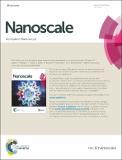Files in this item
Size dependence of efficiency of PbS quantum dots in NiO-based dye sensitised solar cells and mechanistic charge transfer investigation
Item metadata
| dc.contributor.author | Raissi, Mahfoudh | |
| dc.contributor.author | Sajjad, Muhammad Tariq | |
| dc.contributor.author | Pellegrin, Yann | |
| dc.contributor.author | Roland, Thomas Jean | |
| dc.contributor.author | Jobic, Stephane | |
| dc.contributor.author | Boujtita, Mohammed | |
| dc.contributor.author | Ruseckas, Arvydas | |
| dc.contributor.author | Samuel, Ifor D. W. | |
| dc.contributor.author | Odobel, Fabrice | |
| dc.date.accessioned | 2018-09-06T23:35:42Z | |
| dc.date.available | 2018-09-06T23:35:42Z | |
| dc.date.issued | 2017-10-28 | |
| dc.identifier | 251160846 | |
| dc.identifier | aecc7a41-77c3-4ba4-8972-7ae1ab9aa3a9 | |
| dc.identifier | 85031899603 | |
| dc.identifier | 000413905200038 | |
| dc.identifier.citation | Raissi , M , Sajjad , M T , Pellegrin , Y , Roland , T J , Jobic , S , Boujtita , M , Ruseckas , A , Samuel , I D W & Odobel , F 2017 , ' Size dependence of efficiency of PbS quantum dots in NiO-based dye sensitised solar cells and mechanistic charge transfer investigation ' , Nanoscale , vol. 9 , no. 40 , pp. 15566-15575 . https://doi.org/10.1039/C7NR03698A | en |
| dc.identifier.issn | 2040-3364 | |
| dc.identifier.other | Bibtex: urn:530e16d882c3b6e5cd2522f028cd4cd8 | |
| dc.identifier.other | ORCID: /0000-0001-9114-3522/work/37255569 | |
| dc.identifier.uri | https://hdl.handle.net/10023/15985 | |
| dc.description | ANR is gratefully acknowledged for the financial support of these researches through the QuePhelec project (n° ANR-13-BS10-0011-01). Région des Pays de la Loire and Nantes University for the project LUMOMAT are also acknowledged. We acknowledge support from the European Research Council (grant number 321305) and the EPSRC (grant number EP/L017008/1). IDWS is a Royal Society Wolfson Research Merit award holder. The research data supporting this publication can be accessed at http://dx.doi.org/10.17630/ddaebfb9-e127-43cb-9048-966a572b50ac. | en |
| dc.description.abstract | Quantum dots (QDs) are very attractive materials for solar cells due to their high absorption coefficients, size dependence and easy tunability of their optical and electronic properties due to quantum confinement. Particularly interesting are the PbS QDs owing to their broad spectral absorption until the long wavelengths, their easy processability and low cost. Here, we used control of the PbS QDs size to understand charge transfer processes at the interfaces of NiO semiconductor and explain the optimal QDs size in photovoltaic devices. Towards this goal, we have synthesized a series of PbS QDs with different diameters (2.8 A until 4A) and investigated charge transfer dynamics by time resolved spectroscopy and their ability to act as sensitizers in nanocrystalline NiO based solar cells using the cobalt tris(4,4'-diterbutyl-2,2'-bipyridine) complex as redox mediator. We found that PbS QDs with average diameter of 3.0 nm are optimal size in terms of efficient charge transfers and light harvesting efficiency for photovoltaic performances. Our study showed that an hole injection from PbS QDs to NiO valence band (VB) is an efficient process even with low injection driving force (0.3 eV) and occurs in 6-10 ns. Furthermore we found that the direct electrolyte reduction (photoinduced electron transfer to the cobalt redox mediator) also occurs in parallel to the hole injection with rate constant of similar magnitude (10-20 ns). In spite of its large driving force, the rate constant of the oxidative quenching of PbS by Co(III) diminishes more steeply than hole injection on NiO when the diameter of PbS increases. This is understood as the consequence of increasing the trap states that limit electron shift. We believe that our detailed findings will advance the future design of QD sensitized photocathodes. | |
| dc.format.extent | 1732160 | |
| dc.language.iso | eng | |
| dc.relation.ispartof | Nanoscale | en |
| dc.subject | QC Physics | en |
| dc.subject | TK Electrical engineering. Electronics Nuclear engineering | en |
| dc.subject | DAS | en |
| dc.subject | SDG 7 - Affordable and Clean Energy | en |
| dc.subject.lcc | QC | en |
| dc.subject.lcc | TK | en |
| dc.title | Size dependence of efficiency of PbS quantum dots in NiO-based dye sensitised solar cells and mechanistic charge transfer investigation | en |
| dc.type | Journal article | en |
| dc.contributor.sponsor | EPSRC | en |
| dc.contributor.sponsor | European Research Council | en |
| dc.contributor.institution | University of St Andrews. School of Physics and Astronomy | en |
| dc.contributor.institution | University of St Andrews. Condensed Matter Physics | en |
| dc.identifier.doi | 10.1039/C7NR03698A | |
| dc.description.status | Peer reviewed | en |
| dc.date.embargoedUntil | 2018-09-07 | |
| dc.identifier.grantnumber | ep/l017008/1 | en |
| dc.identifier.grantnumber | en |
This item appears in the following Collection(s)
Items in the St Andrews Research Repository are protected by copyright, with all rights reserved, unless otherwise indicated.

